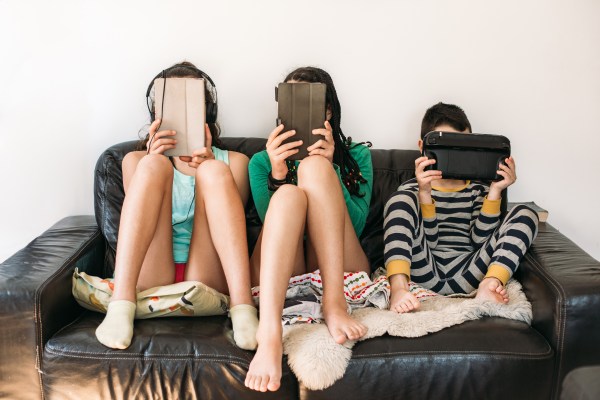No wonder YouTube launched Shorts. A new study of children’s online habits found that children ages 4 through 18 spent a global average of 112 minutes daily on TikTok’s short video app in 2023, an increase from 107 minutes the year prior. And although YouTube remains the world’s biggest streaming app among this demographic, kids spent 60% more time on TikTok last year. The data, from a new study on kids’ digital media, also examined kids’ use of novel technologies like OpenAI’s ChatGPT.
The study, which takes into account the digital media habits of over 400,000 families and schools worldwide, hails from parent control software maker Qustodio. In its annual report, the company paints a picture of the digital habits of kids and their technology usage across mobile and desktop devices, with deep dives into select markets, including the U.S., U.K., Spain, Australia, and France. What’s unique about its dataset is that it comes from kids’ real-world usage of technology, rather than panelist questions. However, the data may not be fully representative of kids’ digital media habits, since its slice of the market represents those households and schools using its parental control software.
Still, it’s a large body of data to pull from and reveals some overall trends that speak to how kids, both younger and older, are engaging with technology.
Notably, the firm for the first time this year looked into kids’ use of new technologies, including AI.
Because ChatGPT didn’t launch on iOS until May and on Android in July, Qustodio chose to look solely at the usage of OpenAI’s website. Globally, it found that almost 20% of kids accessed the site last year, making it the 18th most-visited site for the year. In the U.S., 18.7% of kids visited the site, and it was in 32nd place overall. Australia saw the largest adoption, as 24% of kids visited the site in 2023.

Image Credits: Qustodio
On the streaming front, children spent 27% more time watching streaming services than they did last year, though the price hikes at some services may have impacted their viewership numbers. The firm found that kids spent 4% less time watching Netflix in 2023, 23% less time on Disney+, and 12% less time on Hulu. Meanwhile, YouTube and its sister app YouTube Kids beat records, with watch time for the latter growing by 14% globally, reaching 96 minutes per day, on average — the highest figure Qustodio has seen since the start of its data collection in 2019. YouTube was at 70 minutes, up from 67 last year.

Image Credits: Qustodio
Though Netflix raised prices and cracked down on passwords in 2023, it still remained the second most popular streamer worldwide among kids, as 40% used the service. YouTube was in first place, with 63% of kids using it, and Disney+ was in third place, at 20%. However, Netflix was the only paid service to grow in popularity year-over-year, as other streamers saw their percentages drop, including Disney+, Amazon Prime Video, and Hulu, as well as livestreaming service Twitch, which dropped from 11% of kids using the service in 2022 to just 8% in 2023. Those who remained on Twitch this year boosted their viewing hours, watching 16% more livestreams globally at 22 minutes per day, on average.
Despite growing concerns among parents and legislators about social media’s harms, the use of social media apps among kids was as popular as ever in 2023, for better or for worse.
TikTok remained the most popular app globally, used by 44% of kids, and Facebook, proving its staying power, was the second most popular, used by 38%.

Image Credits: Qustodio
Elon Musk’s X seemed to live up to the mantra that “no press is bad press,” Qustodio says, as Twitter’s rebranding saw 38% of the younger demographic using the platform last year, up from 30% in 2022. (But it seems parents took note of the changes at X, too, making it the third most blocked service globally, behind TikTok and Instagram.)
Rounding out the list of most popular social apps globally were Reddit, Instagram, and Pinterest, at 32%, 32%, and 31% usage, respectively.
The list looks a little different in the U.S., though, as TikTok is followed by X, Reddit, Facebook, Pinterest, and then Instagram.
Still, TikTok gobbled up far more time than its rivals, with usage of 112 minutes per day, on average globally, compared with 63 minutes for Instagram, 19 for Facebook, 16 for Pinterest, 10 for X, and 9 minutes for Reddit.
Related, Meta’s WhatsApp maintained a top spot as the most popular messaging app globally, used by 37% of kids, ahead of Snapchat (35%), Discord (31%), Messages (28%), Skype (21%) and Google Duo (13%). However, Snapchat was by far the app kids spent the most time on, with an average of 74 minutes per day, well ahead of its next nearest rival, Discord, at 27 minutes per day. If it had been categorized among the social apps instead of the communication apps, that would have made it the No. 3 app by time spent.

Image Credits: Qustodio
Among gaming apps, Roblox was the most popular, used by 48% of kids for an average of 130 minutes per day globally, followed by Minecraft, Among Us, Clash Royale, Stumble Guys, and Magic Tiles 3.

Image Credits: Qustodio
Kids also continued to use popular learning apps last year, like those provided by their schools, such as Google Classroom, as well as those in the educational space, like top apps Duolingo, Photomath, Kahoot!, Quizlet, Simply Piano, and Brainly.

Image Credits: Qustodio
In addition to delving into market trends, the full report also deals with how parents should approach managing and monitoring their kids’ technology usage, and what to expect in the future. For the latter, Qustodio cautioned parents that AI tools are expected to grow by almost 40% per year between 2023 and 2030, though among younger kids (ages 10 to 13), only 6% said they were active users.
